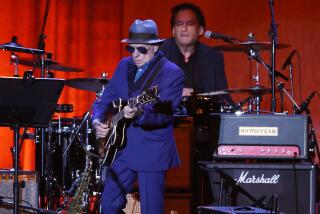The Stones Start Up
- Share via
PHILADELPHIA — The start of the Rolling Stones’ first U.S. tour in eight years had the feel Thursday night of a former champion stepping into the ring after a long layoff.
Sound familiar?
If the returning warrior was also a subtheme of the Who’s recent U.S reunion, there are significant differences between the way the two legendary British bands from the ‘60s went about returning to action.
The Who did everything possible to make sure everyone understood its shows were merely exhibitions--a series of toasts to the band’s past. That was a conservative approach that worked because of the continuing strength of the magnificent Pete Townshend songs.
By contrast, the Stones put together a dazzling show, one built around both glitz and grit. While riskier than the Who undertaking, it has the potential to be more satisfying. The challenge: establishing greater point of view.
The set itself is spectacular: a vaguely disturbing scene of urban decay not far from the dark, menacing vision of “Blade Runner.” The giant stage, with its imaginative lighting, resembles a construction site, complete with giant orange girders and huge, dangling air shafts.
The staging effect aims for the immediacy of an old-fashioned free concert--as if the Stones has suddenly shown up for a concert in the city the way the band once did for a concert in London’s Hyde Park.
If that ambitiousness was one sign of the competitiveness of the Stones this time around, the show itself was equal evidence.
Stones guitarist Keith Richards, in a recent interview, pointed to the absurdity of the “world’s greatest rock band” tag, one that was given the Stones, almost by acclamation, after the breakup of the Beatles in 1970.
The truth is, as Richards noted, “on any given night, a different band can be the greatest in the world, when nothing goes wrong and it’s flying.”
Still, various individuals or bands in rock have performed on record and on stage with such brilliance and consistency that they have become the standard of excellence or excitement.
For years, the Stones set that level. Even if the quality of the albums and live shows varied, the Stones unleashed a power on their 1969 U.S. tour and on their 1972 “Exile on Main Street” album that made them seem untouchable.
So, it wasn’t until the Stones abandoned the road in the mid-’80s that people even began thinking in terms of a new “world’s greatest rock group.”
While there has been no consensus, some contenders have emerged, notably Ireland’s U2, but also among hard-rock newcomers--Guns N’ Roses and Metallica--or among such more traditional American bands as R.E.M. and the Replacements.
Still, interest in the Stones has been strong around the country, including Los Angeles, where the band (and regular tour opener Living Colour) will be joined Oct. 21 and 22 by Guns N’ Roses. Both shows at the 72,000-capacity Memorial Coliseum sold out virtually as fast as tickets could be processed.
In perhaps a wry wink at the Stones’ elder-statesman role in rock, Jagger (now 46) strolled on stage at the 56,000-seat Veterans Stadium here wearing tails--though playfully irreverent tails: a bright green leather jacket and tight, matador trousers. Richards wore a black sport jacket and jeans.
As with the Who, the Stones brought along a supporting cast: two keyboardists, four horn players and three backup singers. But they were more anonymous than the Who’s team, which seemed almost integrated into the band rather than support for it.
Kicking off, predictably, with a high-energy series of songs, including “Start Me Up” and “Shattered,” the band came to an unexpected halt when a generator went out, cutting off necessary stage power.
It may become part of Stones legend that the band was playing with such fury that they blew the generator themselves, but the truth was the band seemed a bit tentative on the early numbers. Yes, even the Stones may suffer from a bit of stage jitters after all this time.
A larger problem emerged as the show continued following the brief interruption. Even after two months of training (rehearsals), the champ--scheduled to give a second performance here Friday night--seemed somewhat unfocused.
If the Stones truly want to be judged against the best of today’s bands and not just for its historical contribution, the band has got to find something to say to us.
The issue surfaced on the just released “Steel Wheels” album. While the songs sound like classic Stones on a purely musical level, there is little fresh or convincing thematic substance.
Similarly, the 28 songs in a nearly three-hour set that didn’t end until after midnight didn’t seem organized in any coherent way.
Why tuck “Rock and a Hard Place,” the one slice of social comment from the new album, in between a lighthearted treatment of “Honky Tonk Women” (highlighted by two, 50-foot inflatable women figures on stage) and a no-longer sinister “Midnight Rambler”?
Similarly, “Tumbling Dice,” one of the Stones’ masterworks, was simply tossed in after a somewhat busy and unaffecting treatment of “Harlem Shuffle” and before the plaintive “Miss You.”
For all Jagger’s reminders that “it’s only rock ‘n’ roll,” there is more to great rock music than simply a musical celebration--there is a reflectiveness and commentary, and it is bands like the Stones that helped give the music this essential added ingredient.
This doesn’t mean the band has to start making social comments on stage. Richards has said the challenge for the Stones is to see how far they can extend the limits of rock ‘n’ roll--to see if rock musicians can continue effectively into their 50s and 60s in the manner of the bluesmen he so greatly admires.
Here’s one way to begin doing that: Rather than simply offer a supermarket cross section of hits, concentrate on songs that have some thematic meaning today.
This would mean, presumably, some of the more intimate Stones tunes--including the wistful “Wild Horses,” “Black Limousine” and “Waiting for a Friend”--that hold up better than some of the more familiar, but also dated signature numbers. One starting place would be “Slipping Away,” the most engaging song on the new album.
After the sluggish start, the band was in blistering form during the concert’s final hour, a segment kicked off by a galvanizing version of “Sympathy for the Devil,” where Richards seemed to step forth and all but reclaim the band’s old crown with some inspired licks.
But the evening’s most touching--and revealing moment--came earlier when Jagger, who has curbed some of the manic, caricature-like gestures that he demonstrated on the ’81 tour, stepped back when he heard the audience singing along on “You Can’t Always Get What You Want” and let them sing alone for a few bars.
It was one of those magical moments in a concert where everyone comes together in a sort of emotional bonding, a moment that also occurred during parts of the Who tour, notably the “Tommy” sequence.
If the Stones can step down from their near three-decade reign as rock “legends” and find more ways to connect with the audience on a personal level, this could be a remarkable tour. But the band has to reach into itself and its music more deeply.
There is certainly some motivation. Unlike the Who, the Stones have support acts and there is always the danger of the former champion being upstaged by a young contender.
While Living Colour is a highly regarded band, the real contest will be in Los Angeles, where Guns N’ Roses is waiting.
More to Read
The biggest entertainment stories
Get our big stories about Hollywood, film, television, music, arts, culture and more right in your inbox as soon as they publish.
You may occasionally receive promotional content from the Los Angeles Times.










